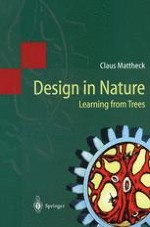1998 | OriginalPaper | Buchkapitel
Unity in Diversity: Design Target and Realization
verfasst von : Prof. Dr. Claus Mattheck
Erschienen in: Design in Nature
Verlag: Springer Berlin Heidelberg
Enthalten in: Professional Book Archive
Aktivieren Sie unsere intelligente Suche, um passende Fachinhalte oder Patente zu finden.
Wählen Sie Textabschnitte aus um mit Künstlicher Intelligenz passenden Patente zu finden. powered by
Markieren Sie Textabschnitte, um KI-gestützt weitere passende Inhalte zu finden. powered by
The aim of improving the chances of survival of a plant or animal species by minimizing the energy requirement is recognizable in all the preceding individual cases examined. The demand for light-weight design with adequate strength is automatically implied. In plants, which do not break down the less heavily loaded zones of the component, the gain is probably only a more economical use of building material. Animals which move about often have the additional possibility of actively breaking down unneeded ballast. In nature, the light-weight principle goes relentlessly on, to the extent that some individuals are readily sacrificed for it. Safety factors in design are kept so low by natural competition that a few of the biological load-bearing structures will fail mechanically under unaccustomed loads. This is, however, sensible in order to be able to preserve the whole species more cheaply. Our own bones fracture occasionally. They are just as underbuilt for a leap from the 6th floor as a tree in a dense stand is for a wind force 12 which it never experiences. A tree with excessive safety factors would forfeit height and therefore light absorption, just as the overweight mammal would experience competitive disadvantages by increasing immobility. Our technical constructions are an exception in the context of these energy-saving emergency sacrifices. We humans want to avoid any sensibly conceivable damage in the normal operation of a component. The idea of accepting a certain in-service damage rate and hence accident rate with a motor vehicle, in order to reduce the fuel consumption of the totality of motor vehicles by more riskily light-weight construction, is foreign to us. This profoundly human social behaviour is unnatural, when measured only against the merciless criteria of biological design targets. We must wait and see whether this increased safety of the individual based on over-dimensioning will have to be paid for by more rapid destruction of the environment and thus the destruction of the species as a whole.
